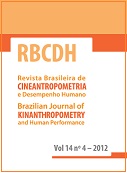Adaptações neuromusculares ao treinamento de força e concorrente em homens idosos.
DOI:
https://doi.org/10.1590/1980-0037.2012v14n4p483Resumen
O objetivo desse estudo foi revisar os resultados acerca das adaptações neuro-musculares ao treinamento de força (TF) e concorrente (TC) em homens idosos. Foram consultadas as bases de dados da Pubmed, Scopus e Scielo de 1980 a 2012. A partir dessa busca, 3390 artigos tiveram seus títulos avaliados e 127 foram selecionados para uma segunda análise para leitura dos abstracts. Destes, 92 artigos foram lidos completamente e 25 artigos foram selecionados e tiveram seus resultados descritos. Diversos estudos demonstraram que idosos submetidos ao TF apresentam aumento na força, potência, ativação e massa muscular. A melhora na força decorrente do TF pode ser explicada através de adaptações neurais e morfológicas. As principais adaptações neurais ao TF consistem no aumento no recrutamento das unidades motoras (UMs), bem como no aumento na freqüência de disparo das UMs. Já as adaptações morfológicas incluem o aumento da área de secção transversa (AST) fisiológica muscular, bem como no aumento na espessura muscular, ângulo de penação das fibras e modificações nas isoformas de cadeia pesada de miosina e conversão de fibras do subtipo IIX para IIa. Recomenda-se a inclusão do TF de intensidade moderada a alta (65-85% da força máxima) na rotina dessa população para a melhora da função neuromuscular. Embora o TC promova adaptações neuromusculares significativas, a magnitude dessas adaptações pode ser inferior quando comparada ao TF. Apesar de o TC resultar em interferência nas adaptações neuromusculares, o TC também promove melhora na função cardiovascular, sendo essa intervenção mais recomendada para promoção da saúde em idosos.
Descargas
Publicado
Número
Sección
Licencia

Direitos Autorais para artigos publicados nesta revista são do autor, com direitos de primeira publicação para a revista. Em virtude da aparecerem nesta revista de acesso público, os artigos são de uso gratuito, com atribuições próprias, em aplicações educacionais e não-comerciais, desde que seja dada a atribuição. Esta obra foi licenciada com uma Licença Creative Commons Atribuição 4.0 Internacional - CC BY


